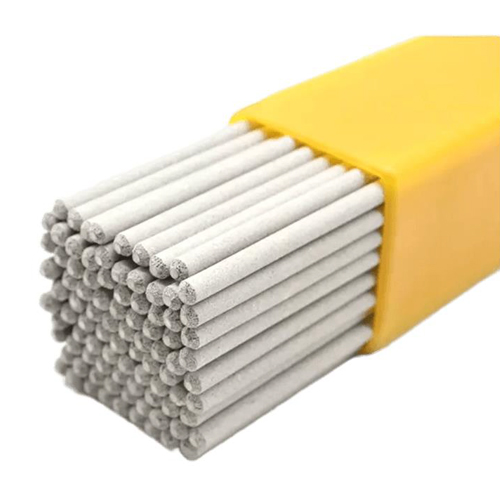

íshín-1682Rx deposits weld metal containing 15.5 Cr, 8.5 Ni, 1.5 Mo. These electrodes are used primarily for welding stainless steel, such as Types 16-8-2, 316, and 347, for high-pressure, high-temperature piping systems. The weld deposit usually has a Ferrite Number no higher than 5 FN. The deposit also has good, hot ductility properties which offer relative freedom from weld or crater cracking even under high-restraint conditions. The welded metal is usable in either the as-welded or solution-treated condition. These electrodes depend on a very carefully balanced chemical composition to develop their fullest properties. Corrosion tests indicate that Type 16-8-2 weld metal may have less corrosion resistance than Type 316 base metal depending on the corrosive media. Where the weldment is exposed to severely corrosive agents, the surface layers should be deposited with a more corrosion-resistant weld metal.
The covering of these electrodes is a modification of the -16 covering. On horizontal fillet welds, electrodes with a -17 covering tend to produce more of a spray arc and a finer rippled weld-bead surface than do those with the -16 coverings. A slower freezing slag of the -17 covering also permits improved handling characteristics when employing a drag technique. The bead shape on horizontal fillets is typically flat to concave with -17 covered electrodes as compared to flat to slightly convex with -16 covered electrodes. When making fillet welds in the vertical position with upward progression, the slower freezing slag of the -17 covered electrodes requires a slight weave technique to produce the proper bead shape. For this reason, the minimum leg-size fillet that can be properly made with a -17 covered electrode is larger than that for a -16 covered electrode. While these electrodes are designed for all-position operation, electrode sizes 4.8 mm and larger are not recommended for vertical or overhead welding.
Storage and Drying Conditions: Hydrogen can have adverse effects on welds in some steels under certain conditions. One source of this hydrogen is moisture in the electrode coverings. For this reason, the proper storage, treatment, and handling of electrodes are necessary.
Holding Ovens: 125°C–150°C.
Drying Conditions: 250°C–425°C for 1 hour prior to use.
CHEMICAL COMPOSITION OF UNDILUTED WELD
|
C |
Cr |
Ni |
Mo |
Nb+Ta |
Mn |
Si |
P |
S |
N |
Cu |
Others |
|
0.10 |
14.0-16.50 |
7.50-9.50 |
1.00-2.00 |
NS |
0.50-2.50 |
0.60 |
0.03 |
0.03 |
NS |
0.75 |
NS |
Single values are maxima, except where specified otherwise.
ALL-WELD-METAL MECHANICAL PROPERTIES
Heat to 1025°C to 1050°C, hold for one hour (–0, +15 minutes), and air cool to ambient, and then precipitation harden at 610°C to 630°C, hold for four hours (–0, +15 minutes), and air cool to ambient. Preheat: 150°C minimum and Interpass Temperature: 260°C maximum
|
Tensile Strength, MPa |
Yield Strength, At 0.2% Offset, MPa |
Elongation % |
Lateral Expansion, mm |
Charpy V-Notch Impact at NS°C, Joules |
|
930 |
NS |
7 |
NS |
NS |
Single values are minimal.
ELECTRODE SIZE & WELDING CURRENT (AC and DCEP)
|
DIAMETER, mm |
LENGTH, mm |
Amperes |
|
2.50 |
350 |
65-90 |
|
3.15, 3.20 |
350 |
90-120 |
|
4.00 |
350 |
120-150 |
|
5.00 |
350 |
160-200 |
WARNING: Safety and health information is available from many sources, including, but not limited to Safety and Health Fact Sheets listed in A11.3, ANSI Z49.1 Safety in Welding, Cutting, and Allied Processes published by the American Welding Society, 8669 Doral Blvd., Suite 130, Doral, FL 33166., and applicable federal and state regulations. The Safety and Health Fact Sheets are revised, and additional sheets added periodically.
